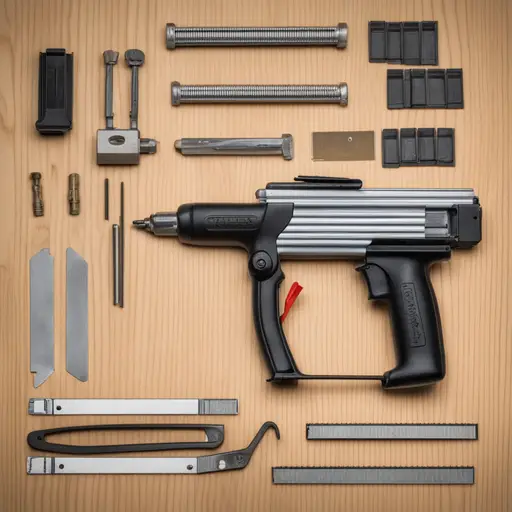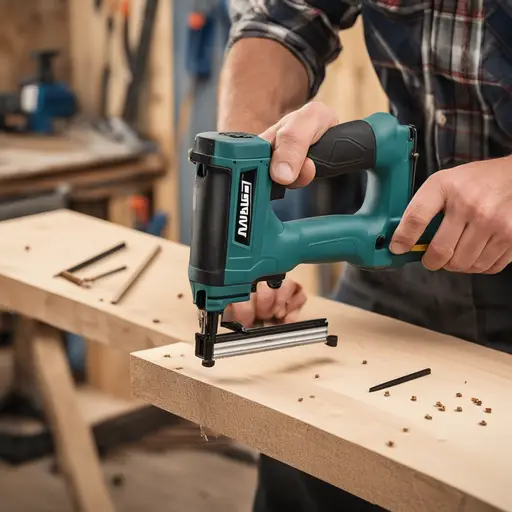You’ve probably heard of nail guns, but what about pin nailers? They’re not as well-known, but they’re just as handy. If you’re a DIY enthusiast or a professional woodworker, you’ll find a pin nailer can be your secret weapon.
Let’s delve into what a pin nailer is, its uses, features to look for, safety measures and troubleshooting tips. We’ll help you master this tool, giving you the freedom to create with precision and ease.
Key Takeaways
Table of Contents
- Pin nailers are designed for delicate materials and leave almost invisible holes.
- They are versatile and can secure fine trim and delicate crown molding with ease.
- Pin nailers lack holding power and are not designed for heavy-duty jobs.
- Proper maintenance and troubleshooting techniques can extend the lifespan of the pin nailer and keep it running smoothly.
Understanding the Basics of a Pin Nailer

You’ve got to understand, a pin nailer is a type of nail gun that uses thin, headless pins. This device is a testament to the Pin Nailer Evolution, and its design is all about freedom.
Freedom to work on delicate materials without splitting, freedom to leave almost invisible holes. It’s a liberating tool for carpenters, hobbyists, and DIY enthusiasts alike.
However, there are Pin Nailer Alternatives. Brad nailers, for instance, offer greater holding power but leave larger holes. Staple guns can also be an option, especially for upholstery.
Yet, the pin nailer stands out for its precision and minimal trace. It’s a tool designed for the detailed and the delicate, a true evolution in the world of carpentry.
The Functionality and Uses of a Pin Nailer

It’s primarily used to fasten delicate pieces together without leaving noticeable holes or causing the wood to split. This is the pin nailer’s versatility. You’re able to secure fine trim and delicate crown molding with ease. It’s a tool that gives you the liberty to work on intricate jobs without worry of damaging your materials.
Yet, remember the pin nailer limitations as well. While it’s great for small, delicate pieces, it’s not designed for heavy-duty jobs. You can’t rely on it for structural integrity; it simply doesn’t have the holding power.
Key Features to Consider When Buying a Pin Nailer

When you’re in the market for this type of tool, there’re several key features you should consider.
Freedom to choose is vital, and the key to making the right choice lies in understanding the technical aspects of a pin nailer’s features.
- Pin Nailer Durability: You’ll want a robust tool that’ll stand the test of time. Look for sturdy construction material, like aluminum or steel.
- Nailing Precision: A pin nailer should offer precise nailing, so consider its depth adjustment capabilities.
- Ergonomics: A comfortable grip and balance are crucial for long projects.
- Power Source: Consider whether you prefer corded electric, battery-powered, or pneumatic models.
How to Safely Operate a Pin Nailer

Before you start using your new tool, let’s discuss some safety measures you’ll want to implement to prevent any mishaps. Choosing the right ‘nailer safety gear’ and implementing ‘accident prevention techniques’ can make all the difference.
Here’s a table that breaks down the items you’ll need and why they’re important:
| Safety Gear | Purpose | Where to Use |
|---|---|---|
| Safety Glasses | Protects eyes from flying debris | Always when operating the nailer |
| Work Gloves | Protects hands from accidental nail discharge | Always when handling the nailer |
| Ear Protection | Protects hearing from loud noises | In high noise environments |
Don’t neglect these measures. They’re your ticket to a successful project, free from the constraints of injury and damage. Remember, you’re looking for freedom in your work, not restrictions due to unnecessary accidents.
Maintaining and Troubleshooting Common Issues With a Pin Nailer

Maintaining your tool properly and being aware of how to troubleshoot common issues can significantly extend its lifespan and keep it running smoothly. Nail Jamming Solutions and the Lubrication Importance are essential aspects of maintaining a pin nailer.
Here’s a practical guide to help you:
- Always clear the nailer of any nail jam. Use needle-nose pliers to do this safely.
- Regularly lubricate your pin nailer. It reduces internal friction, protecting the tool from wear and tear.
- Never force a jammed nailer. It can damage internal components.
- Keep your tool clean. Debris can cause mechanical malfunctions.
Frequently Asked Questions
What Are Some Well-Known Brands That Manufacture Pin Nailers?
You’re likely familiar with brands like Hitachi, Bostitch, and Porter-Cable. They’re known for pin nailers’ production, ensuring optimal pin nailer maintenance and strict safety protocols for their use.
Can a Pin Nailer Be Used for Large Scale Construction Projects?
While you can use a pin nailer for large scale construction, it’s not ideal. The pin nailer’s limitations affect project efficiency. It’s better suited for delicate, fine woodworking rather than heavy-duty construction tasks.
How Does a Pin Nailer Compare in Cost to Other Types of Nail Guns?
Comparing costs, you’ll find pin nailers are generally less expensive. However, remember that pin nailer maintenance can add up. Also, safety precautions are crucial to avoid unnecessary expenses from mishandling these tools.
Are There Any Specific Training Programs or Certifications Needed to Operate a Pin Nailer Professionally?
Specific training isn’t typically required to operate a pin nailer professionally. However, learning Pin Nailer Safety and Nailer Operation Techniques can significantly improve your skills and safety on the job.
What Are Some Environmental Considerations to Keep in Mind When Using a Pin Nailer?
When using a pin nailer, consider the noise pollution and waste produced. You should use it responsibly, maintaining Pin Nailer Safety and promoting Sustainable Usage to protect the environment and your personal freedom.
Conclusion
In conclusion, a pin nailer is a must-have tool for your woodworking projects. It’s ideal for intricate tasks due to its precision. However, don’t forget to consider key features like the size, power source, and adjustability before buying.
Always operate it safely to prevent accidents. Regular maintenance and swift troubleshooting are also crucial for its longevity. So, treat your pin nailer right and it’ll serve you well.